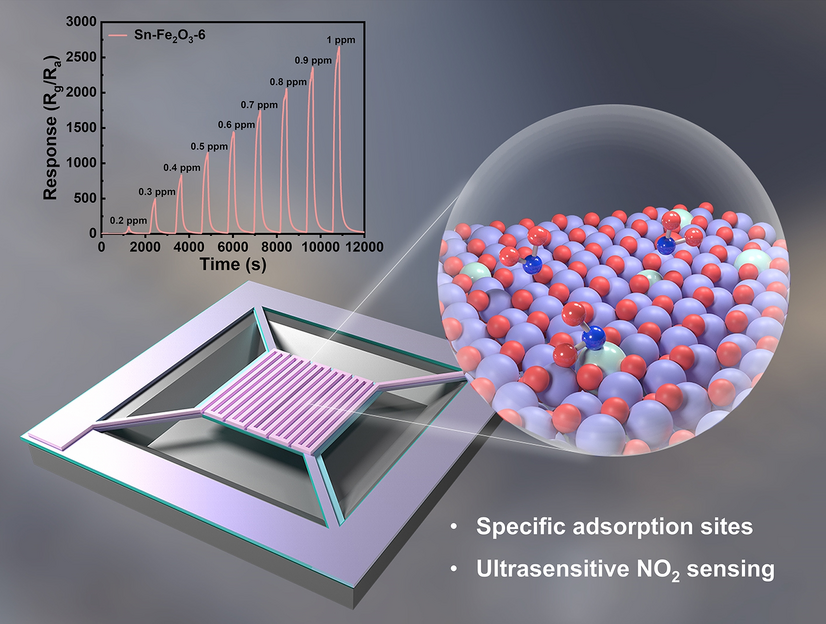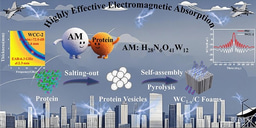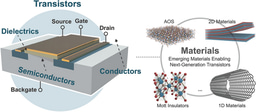Specific Sn–O–Fe Active Sites from Atomically Sn-Doping Porous Fe2O3 for Ultrasensitive NO2 Detection

Led by Prof. Xuhui Sun at Soochow University’s Institute of Functional Nano & Soft Materials (FUNSOM), a team has devised a metal–organic-framework (MOF)-derived α-Fe2O3 scaffold in which single Sn atoms occupy Fe lattice positions, forging Sn–O–Fe bridges. This first-of-its-kind single-atom architecture, reported in Nano-Micro Letters, delivers record-breaking NO2 sensitivity (Rg/Ra = 2,646 at 1 ppm, 10 ppb limit of detection) at only 150 °C, while a MEMS implementation sips 8 mW—five-fold lower than commercial MOS sensors.
Why This Work Matters
- Health & Regulation: WHO sets 82 ppb as the 1-hour NO2 exposure limit. The new sensor reliably quantifies 10 ppb—an order of magnitude lower—enabling early indoor/outdoor pollution alerts.
- Energy Footprint: 150 °C operating temperature plus 8 mW power budget (0.7 V micro-hotplate) unlock battery-driven wearables, IoT nodes and drone-mounted grids.
- Selectivity: Sn–O–Fe sites suppress cross-responses to SO2, NH3, H2S, acetone and CO (<5 % relative signal), eliminating false alarms in complex exhaust streams.
- Stability: >60 days continuous operation and humidity immunity (0–90 % RH) meet industrial-grade reliability.
Innovative Design & Mechanisms
- MOF-to-SAC Synthesis
– Fe-MIL-88B-NH2 MOF “molecular fences” pre-isolate Sn4+ ions (2–8 at %).
– One-step 500 °C air anneal converts MOF into porous α-Fe2O3 while locking Sn atoms into exact Fe sites (HAADF-STEM shows bright single dots; no SnO2 clusters until 8 at %).
- Electronic Structure Engineering
– XANES + DFT: Sn donation narrows bandgap from 2.24 eV (pristine) to 1.67 eV, increasing electron density at 150 °C.
– Oxygen-vacancy-rich lattice (EPR g = 2.005) further accelerates O₂⁻ formation and NO₂ charge transfer.
- Adsorption & Kinetics
– DFT shows NO2 binds at −2.20 eV on Sn–O–Fe vs −0.48 eV on Fe–O–Fe, cutting response/recovery times to 16 s / 148 s.
– Linear calibration (R2 = 0.996) spans 0.2–1 ppm for alumina substrates and 10–50 ppb for MEMS chips.
Applications & Future Outlook
- Smart Cities: Wafer-level MEMS arrays (3 × 3 × 1.3 mm3) integrate into streetlights and HVAC ducts for distributed NO2 mapping.
- Wearable Health: Flexible PET patches (demonstrated in lab) provide personal exposure analytics with BLE transmission to smartphones.
- Industrial Safety: Explosion-proof probes for petrochemical stacks (150 °C operation eliminates need for flame-proof heaters).
- Roadmap: Roll-to-roll coating of Sn-Fe2O3 inks on polyimide foils, AI-driven drift compensation, and extension to SO2 and VOC single-atom sensors.
Conclusions
By merging single-atom catalysis with semiconductor gas sensing, Prof. Sun’s group achieves the first ppb-level NO2 detector that marries high sensitivity, low power and scalable fabrication. The MOF-derived Sn–O–Fe platform not only redefines NO2 monitoring but also sets a universal blueprint for atomically engineered MOS sensors across toxic and greenhouse gases.
Follow the Topic
-
Nano-Micro Letters

Nano-Micro Letters is a peer-reviewed, international, interdisciplinary and open-access journal that focus on science, experiments, engineering, technologies and applications of nano- or microscale structure and system in physics, chemistry, biology, material science, and pharmacy.






Please sign in or register for FREE
If you are a registered user on Research Communities by Springer Nature, please sign in